The Big Build: Artemis I Stacks Up
The Big Build: Artemis I Stacks Up
Our Space Launch System (SLS) rocket is coming together at the agency’s Kennedy Space Center in Florida this summer. Our mighty SLS rocket is set to power the Artemis I mission to send our Orion spacecraft around the Moon. But, before it heads to the Moon, NASA puts it together right here on Earth.

Read on for more on how our Moon rocket for Artemis I will come together this summer:
Get the Base

How do crews assemble a rocket and spacecraft as tall as a skyscraper? The process all starts inside the iconic Vehicle Assembly Building at Kennedy with the mobile launcher. Recognized as a Florida Space Coast landmark, the Vehicle Assembly Building, or VAB, houses special cranes, lifts, and equipment to move and connect the spaceflight hardware together. Orion and all five of the major parts of the Artemis I rocket are already at Kennedy in preparation for launch. Inside the VAB, teams carefully stack and connect the elements to the mobile launcher, which serves as a platform for assembly and, later, for fueling and launching the rocket.
Start with the boosters

Because they carry the entire weight of the rocket and spacecraft, the twin solid rocket boosters for our SLS rocket are the first elements to be stacked on the mobile launcher inside the VAB. Crews with NASA’s Exploration Ground Systems and contractor Jacobs team completed stacking the boosters in March. Each taller than the Statue of Liberty and adorned with the iconic NASA “worm” logo, the five-segment boosters flank either side of the rocket’s core stage and upper stage. At launch, each booster produces more than 3.6 million pounds of thrust in just two minutes to quickly lift the rocket and spacecraft off the pad and to space.
Bring in the core stage

In between the twin solid rocket boosters is the core stage. The stage has two huge liquid propellant tanks, computers that control the rocket’s flight, and four RS-25 engines. Weighing more than 188,000 pounds without fuel and standing 212 feet, the core stage is the largest element of the SLS rocket. To place the core stage in between the two boosters, teams will use a heavy-lift crane to raise and lower the stage into place on the mobile launcher.
On launch day, the core stage’s RS-25 engines produce more than 2 million pounds of thrust and ignite just before the boosters. Together, the boosters and engines produce 8.8 million pounds of thrust to send the SLS and Orion into orbit.
Add the Launch Vehicle Stage Adapter
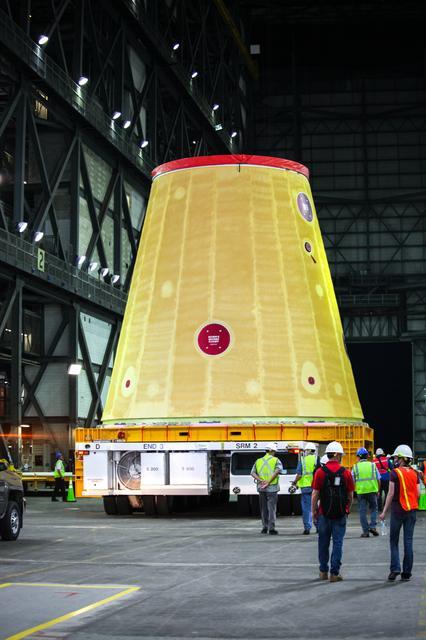
Once the boosters and core stage are secured, teams add the launch vehicle stage adapter, or LVSA, to the stack. The LVSA is a cone-shaped element that connects the rocket’s core stage and Interim Cryogenic Propulsion Stage (ICPS), or upper stage. The roughly 30-foot LVSA houses and protects the RL10 engine that powers the ICPS. Once teams bolt the LVSA into place on top of the rocket, the diameter of SLS will officially change from a wide base to a more narrow point — much like a change in the shape of a pencil from eraser to point.
Lower the Interim Cryogenic Propulsion Stage into place

Next in the stacking line-up is the Interim Cryogenic Propulsion Stage or ICPS. Like the LVSA, crews will lift and bolt the ICPS into place. To help power our deep space missions and goals, our SLS rocket delivers propulsion in phases. At liftoff, the core stage and solid rocket boosters will propel Artemis I off the launch pad. Once in orbit, the ICPS and its single RL10 engine will provide nearly 25,000 pounds of thrust to send our Orion spacecraft on a precise trajectory to the Moon.
Nearly there with the Orion stage adapter

When the Orion stage adapter crowns the top of the ICPS, you’ll know we’re nearly complete with stacking SLS rocket for Artemis I. The Orion Stage Adapter is more than just a connection point. At five feet in height, the Orion stage adapter may be small, but it holds and carries several small satellites called CubeSats. After Orion separates from the SLS rocket and heads to the Moon, these shoebox-sized payloads are released into space for their own missions to conduct science and technology research vital to deep space exploration. Compared to the rest of the rocket and spacecraft, the Orion stage adapter is the smallest SLS component that’s stacked for Artemis I.
Top it off

Finally, our Orion spacecraft will be placed on top of our Moon rocket inside the VAB. The final piece will be easy to spot as teams recently added the bright red NASA “worm” logotype to the outside of the spacecraft. The Orion spacecraft is much more than just a capsule built to carry crew. It has a launch abort system, which will carry the crew to safety in case of an emergency, and a service module developed by the European Space Agency that will power and propel the spacecraft during its three-week mission. On the uncrewed Artemis I mission, Orion will check out the spacecraft’s critical systems, including navigation, communications systems, and the heat shield needed to support astronauts who will fly on Artemis II and beyond.
Ready for launch!

The path to the pad requires many steps and check lists. Before Artemis I rolls to the launch pad, teams will finalize outfitting and other important assembly work inside the VAB. Once assembled, the integrated SLS rocket and Orion will undergo several final tests and checkouts in the VAB and on the launch pad before it’s readied for launch.
The Artemis I mission is the first in a series of increasingly complex missions that will pave the way for landing the first woman and the first person of color on the Moon. The Space Launch System is the only rocket that can send NASA astronauts aboard NASA’s Orion spacecraft and supplies to the Moon in a single mission.
Make sure to follow us on Tumblr for your regular dose of space!
More Posts from Nasa and Others

In temperatures that drop below -20 degrees Fahrenheit, along a route occasionally blocked by wind-driven ice dunes, a hundred miles from any other people, a team led by two of our scientists are surveying an unexplored stretch of Antarctic ice.
They’ve packed extreme cold-weather gear and scientific instruments onto sleds pulled by two tank-like snow machines called PistenBullys, and after a stop at the South Pole Station (seen in this image), they began a two- to three-week traverse.
The 470-mile expedition in one of the most barren landscapes on Earth will ultimately provide the best assessment of the accuracy of data collected from space by the Ice Cloud and land Elevation Satellite-2 (ICESat-2), set to launch in 2018.
This traverse provides an extremely challenging way to assess the accuracy of the data. ICESat-2’s datasets are going to tell us incredible things about how Earth’s ice is changing, and what that means for things like sea level rise.
Make sure to follow us on Tumblr for your regular dose of space: http://nasa.tumblr.com.
Polar Vortex spills Arctic weather into North America

What in the world is a polar vortex? On Earth, it’s a large area of low pressure and extremely cold air that usually swirls over the Arctic, with strong counter-clockwise winds that trap the cold around the Pole. But disturbances in the jet stream and the intrusion of warmer mid-latitude air masses can disturb this polar vortex and make it unstable, sending Arctic air south into middle latitudes.
That has been the case in late January 2019 as frigid weather moves across the Midwest and Northern Plains of the United States, as well as interior Canada. Forecasters are predicting that air temperatures in parts of the continental United States will drop to their lowest levels since at least 1994, with the potential to break all-time record lows for January 30 and 31. With clear skies, steady winds, and snow cover on the ground, as many as 90 million Americans could experience temperatures at or below 0 degrees Fahrenheit (-18° Celsius), according to the National Weather Service (NWS).
The Goddard Earth Observing System Model above shows this air temperature movement at 2 meters (around 6.5 feet above the ground) from January 23-29. You can see some portions of the Arctic are close to the freezing point—significantly warmer than usual for the dark of mid-winter—while masses of cooler air plunge toward the interior of North America.

Science Behind the Polar Vortex / Credit: NOAA
Meteorologists predicted that steady northwest winds (10 to 20 miles per hour) were likely to add to the misery, causing dangerous wind chills below -40°F (-40°C) in portions of 12 states. A wind chill of -20°F can cause frostbite in as little as 30 minutes, according to the weather service.
Not sure how cold that is? Check out the low temperatures on January 30, 2019 in some of the coldest places on Earth—and a planetary neighbor:
-46°F (-43°C) -- Chesterfield, Newfoundland
-36°F (-33°C) -- Yukon Territory, Canada
-33°F (-27°C) -- Fargo, North Dakota (Within the Polar Vortex)
-28°F (-18°C) -- Minneapolis, Minnesota (Within the Polar Vortex)
-27°F (-33°C) -- Amundsen-Scott South Pole Station, Antarctica
-24°F (-31°C) -- Chicago, Illinois (Within the Polar Vortex)
-15°F (5°C) -- Barrow, Alaska
-99°F (-73°C) -- Mars
Learn more about the science behind the polar vortex and how NASA is modeling it here: https://go.nasa.gov/2Wtmb43.
Make sure to follow us on Tumblr for your regular dose of space: http://nasa.tumblr.com
First All-Woman Spacewalk
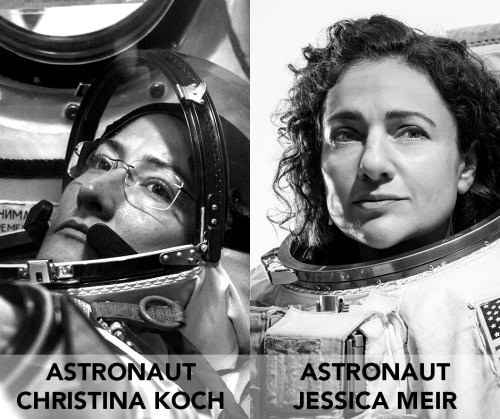
NASA astronauts and best friends, Christina Koch and Jessica Meir, made history Friday, October 18, 2019, by conducting the first all-woman spacewalk outside the International Space Station (ISS)! The Expedition 61 flight engineers ventured into the vacuum of space at 7:38 a.m. EDT to swap out a failed power controller that regulates the batteries used to collect and distribute power to the orbital laboratory – a task that took a total of seven hours and 17 minutes to complete.
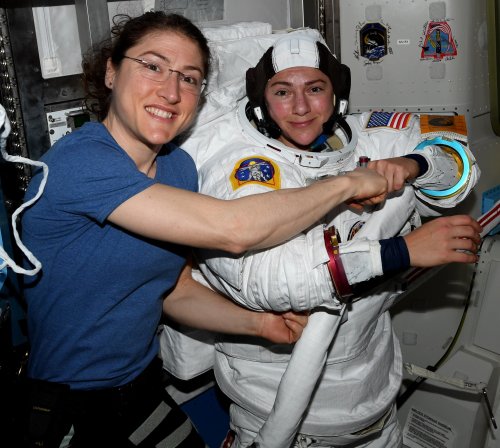
This was Koch’s fourth spacewalk and Meir’s first. Both women, selected as astronaut candidates in 2013, are on their first trip to work and live aboard the space station. Meir will be the 15th woman to spacewalk, and the 14th U.S. woman.
Get to know the astronauts
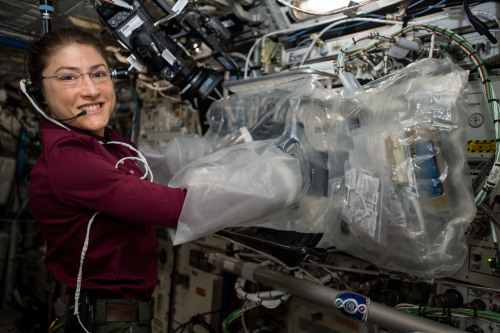
In addition to being an astronaut, Christina Koch is an engineer and physicist. Her career has taken her to extreme parts of the planet to conduct scientific field missions in places like the Antarctic South Pole and Greenland’s Summit Station. Prior to being selected as an astronaut candidate in 2013, she worked as an Electrical Engineer at our Goddard Space Flight Center’s Laboratory for High Energy Astrophysics.
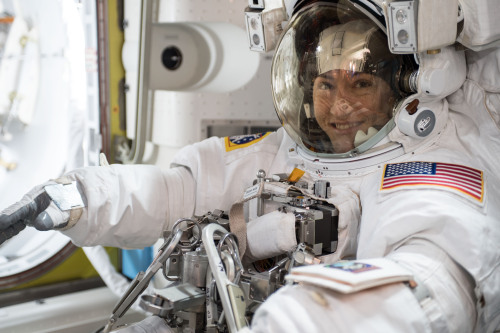
Koch left Earth on March 14, 2019, and is slated to set a record for the longest single spaceflight by a woman with an expected total of 328 days in space. Her extended mission will provide researchers the opportunity to observe the effects of long-duration spaceflight on a female body in preparation for human missions to the Moon and Mars.
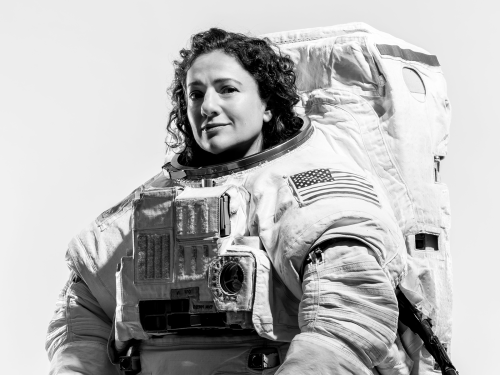
Jessica Meir dreamed of the day she would make it to space since the age of five. That dream became a reality on Wednesday, Sept. 25, 2019 as she left Earth on her first spaceflight – later floating into her new home aboard the International Space Station.
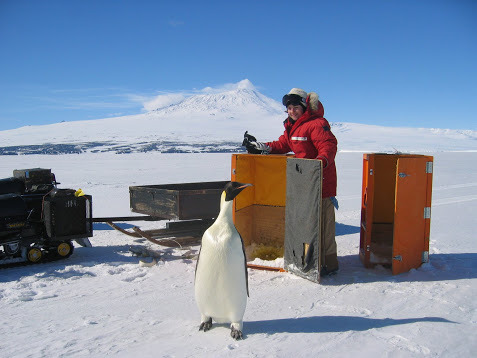
While Meir’s new home is more than 200 miles over the Earth, she is no stranger to extreme environments. She studied penguins in Antarctica and mapped caves in Italy – both of which prepared her for the ultimate extreme environment: space.
#AllWomanSpacewalk, what’s the deal?
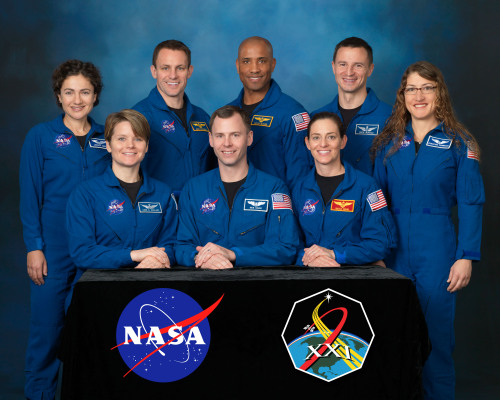
The all-woman spacewalk wasn’t something we purposefully planned; it is a testament to the increasing number of female astronauts in the space program. For example, Koch’s and Meir’s 2013 class of astronaut candidates was 50 percent women!
When asked in an interview about the importance of conducting her mission and this spacewalk, Koch said,
“In the end, I do think it’s important, and I think it’s important because of the historical nature of what we’re doing. In the past women haven’t always been at the table. It’s wonderful to be contributing to the space program at a time when all contributions are being accepted, when everyone has a role. That can lead in turn to increased chance for success. There are a lot of people who derive motivation from inspiring stories of people who look like them, and I think it’s an important story to tell.”
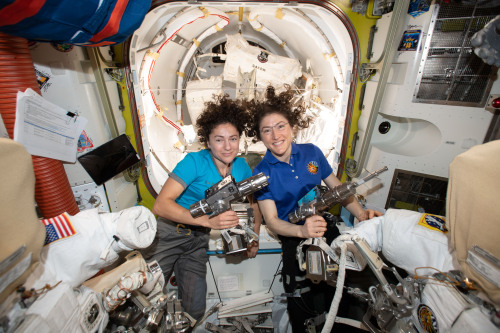
It’s important to note that spacewalks are not easy; astronauts typically describe them as the most physically challenging thing they do. Assignments are made on the basis of which astronauts are the best prepared to accomplish the tasks at hand under the conditions at the time. Today, Koch and Meir were the top astronauts for the job.
Women are no stranger to spacewalks!

While this was the first spacewalk to be conducted entirely by women, women are no strangers to spacewalks. Exactly 35 years and one week ago, Kathryn Sullivan (pictured above) made her own historic debut as the first U.S. woman to conduct a spacewalk. Since then, a total of 14 women (15 including Jessica) have ventured into the vacuum of space on 40 different spacewalks. Former Astronaut Peggy Whitson performed a record number of 10! From Astronauts to mission directors, women have been making their mark at the agency for decades now. A few of our recent pioneers are:
Astronaut Kate Rubins: First person to sequence DNA in space
Astronaut Peggy Whitson: First woman to command the ISS
Sandra Cauffman: Director of our Earth Science’s Division
Nicola Fox: Director of our Heliophysics Division
Lori Glaze: Director of our Planetary Science Division
Coming soon: The first woman to walk on the Moon
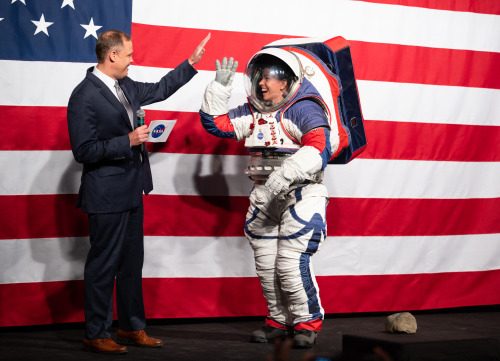
The first all-woman spacewalk is a milestone worth noting and celebrating as we look forward to putting the first woman and the next man on the Moon by 2024 with our Artemis lunar exploration program. With today’s historic event, we once again set a precedence for women to lead in space exploration.
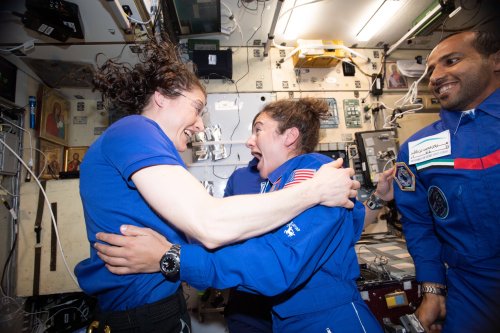
We hope achievements such as this provide inspiration to you all around the world, proving that hard work can lead you to great heights. This is not just a historic day for NASA, but a moment we can all feel proud of.
Didn’t have time to tune in? Check out the replay, here. Koch was wearing the spacesuit with red stripes, while Meir’s had no stripes.
If you’d like to keep up with Christian Koch and Jessica Meir’s work 254 miles above planet Earth, follow them on Twitter at @Astro_ Christina and @Astro_Jessica.
Be sure to follow us on Tumblr for your regular dose of space: http://nasa.tumblr.com
A Tour of Cosmic Temperatures
We often think of space as “cold,” but its temperature can vary enormously depending on where you visit. If the difference between summer and winter on Earth feels extreme, imagine the range of temperatures between the coldest and hottest places in the universe — it’s trillions of degrees! So let’s take a tour of cosmic temperatures … from the coldest spots to the hottest temperatures yet achieved.
First, a little vocabulary: Astronomers use the Kelvin temperature scale, which is represented by the symbol K. Going up by 1 K is the same as going up 1°C, but the scale begins at 0 K, or -273°C, which is also called absolute zero. This is the temperature where the atoms in stuff stop moving. We’ll measure our temperatures in this tour in kelvins, but also convert them to make them more familiar!
We’ll start on the chilly end of the scale with our CAL (Cold Atom Lab) on the International Space Station, which can chill atoms to within one ten billionth of a degree above 0 K, just a fraction above absolute zero.

Credit: NASA's Goddard Space Flight Center/Scott Wiessinger
Just slightly warmer is the Resolve sensor inside XRISM, pronounced “crism,” short for the X-ray Imaging and Spectroscopy Mission. This is an international collaboration led by JAXA (Japan Aerospace Exploration Agency) with NASA and ESA (European Space Agency). Resolve operates at one twentieth of a degree above 0 K. Why? To measure the heat from individual X-rays striking its 36 pixels!

Credit: NASA's Goddard Space Flight Center/Scott Wiessinger
Resolve and CAL are both colder than the Boomerang Nebula, the coldest known region in the cosmos at just 1 K! This cloud of dust and gas left over from a Sun-like star is about 5,000 light-years from Earth. Scientists are studying why it’s colder than the natural background temperature of deep space.

Credit: NASA's Goddard Space Flight Center/Scott Wiessinger
Let’s talk about some temperatures closer to home. Icy gas giant Neptune is the coldest major planet. It has an average temperature of 72 K at the height in its atmosphere where the pressure is equivalent to sea level on Earth. Explore how that compares to other objects in our solar system!

Credit: NASA's Goddard Space Flight Center/Scott Wiessinger
How about Earth? According to NOAA, Death Valley set the world’s surface air temperature record on July 10, 1913. This record of 330 K has yet to be broken — but recent heat waves have come close. (If you’re curious about the coldest temperature measured on Earth, that’d be 183.95 K (-128.6°F or -89.2°C) at Vostok Station, Antarctica, on July 21, 1983.)
We monitor Earth's global average temperature to understand how our planet is changing due to human activities. Last year, 2023, was the warmest year on our record, which stretches back to 1880.

Credit: NASA's Goddard Space Flight Center/Scott Wiessinger
The inside of our planet is even hotter. Earth’s inner core is a solid sphere made of iron and nickel that’s about 759 miles (1,221 kilometers) in radius. It reaches temperatures up to 5,600 K.

Credit: NASA's Goddard Space Flight Center/Scott Wiessinger
We might assume stars would be much hotter than our planet, but the surface of Rigel is only about twice the temperature of Earth’s core at 11,000 K. Rigel is a young, blue star in the constellation Orion, and one of the brightest stars in our night sky.

Credit: NASA's Goddard Space Flight Center/Scott Wiessinger
We study temperatures on large and small scales. The electrons in hydrogen, the most abundant element in the universe, can be stripped away from their atoms in a process called ionization at a temperature around 158,000 K. When these electrons join back up with ionized atoms, light is produced. Ionization is what makes some clouds of gas and dust, like the Orion Nebula, glow.

Credit: NASA's Goddard Space Flight Center/Scott Wiessinger
We already talked about the temperature on a star’s surface, but the material surrounding a star gets much, much hotter! Our Sun’s surface is about 5,800 K (10,000°F or 5,500°C), but the outermost layer of the solar atmosphere, called the corona, can reach millions of kelvins.
Our Parker Solar Probe became the first spacecraft to fly through the corona in 2021, helping us answer questions like why it is so much hotter than the Sun's surface. This is one of the mysteries of the Sun that solar scientists have been trying to figure out for years.

Credit: NASA's Goddard Space Flight Center/Scott Wiessinger
Looking for a hotter spot? Located about 240 million light-years away, the Perseus galaxy cluster contains thousands of galaxies. It’s surrounded by a vast cloud of gas heated up to tens of millions of kelvins that glows in X-ray light. Our telescopes found a giant wave rolling through this cluster’s hot gas, likely due to a smaller cluster grazing it billions of years ago.

Credit: NASA's Goddard Space Flight Center/Scott Wiessinger
Now things are really starting to heat up! When massive stars — ones with eight times the mass of our Sun or more — run out of fuel, they put on a show. On their way to becoming black holes or neutron stars, these stars will shed their outer layers in a supernova explosion. These layers can reach temperatures of 300 million K!

Credit: NASA's Goddard Space Flight Center/Jeremy Schnittman
We couldn’t explore cosmic temperatures without talking about black holes. When stuff gets too close to a black hole, it can become part of a hot, orbiting debris disk with a conical corona swirling above it. As the material churns, it heats up and emits light, making it glow. This hot environment, which can reach temperatures of a billion kelvins, helps us find and study black holes even though they don’t emit light themselves.
JAXA’s XRISM telescope, which we mentioned at the start of our tour, uses its supercool Resolve detector to explore the scorching conditions around these intriguing, extreme objects.

Credit: NASA's Goddard Space Flight Center/CI Lab
Our universe’s origins are even hotter. Just one second after the big bang, our tiny, baby universe consisted of an extremely hot — around 10 billion K — “soup” of light and particles. It had to cool for a few minutes before the first elements could form. The oldest light we can see, the cosmic microwave background, is from about 380,000 years after the big bang, and shows us the heat left over from these earlier moments.

Credit: NASA's Goddard Space Flight Center/Scott Wiessinger
We’ve ventured far in distance and time … but the final spot on our temperature adventure is back on Earth! Scientists use the Large Hadron Collider at CERN to smash teensy particles together at superspeeds to simulate the conditions of the early universe. In 2012, they generated a plasma that was over 5 trillion K, setting a world record for the highest human-made temperature.
Want this tour as a poster? You can download it here in a vertical or horizontal version!

Credit: NASA's Goddard Space Flight Center/Scott Wiessinger
Explore the wonderful and weird cosmos with NASA Universe on X, Facebook, and Instagram. And make sure to follow us on Tumblr for your regular dose of space!

What We Learned from Flying a Helicopter on Mars

The Ingenuity Mars Helicopter made history – not only as the first aircraft to perform powered, controlled flight on another world – but also for exceeding expectations, pushing the limits, and setting the stage for future NASA aerial exploration of other worlds.
Built as a technology demonstration designed to perform up to five experimental test flights over 30 days, Ingenuity performed flight operations from the Martian surface for almost three years. The helicopter ended its mission on Jan. 25, 2024, after sustaining damage to its rotor blades during its 72nd flight.
So, what did we learn from this small but mighty helicopter?
We can fly rotorcraft in the thin atmosphere of other planets.
Ingenuity proved that powered, controlled flight is possible on other worlds when it took to the Martian skies for the first time on April 19, 2021.
Flying on planets like Mars is no easy feat: The Red Planet has a significantly lower gravity – one-third that of Earth’s – and an extremely thin atmosphere, with only 1% the pressure at the surface compared to our planet. This means there are relatively few air molecules with which Ingenuity’s two 4-foot-wide (1.2-meter-wide) rotor blades can interact to achieve flight.
Ingenuity performed several flights dedicated to understanding key aerodynamic effects and how they interact with the structure and control system of the helicopter, providing us with a treasure-trove of data on how aircraft fly in the Martian atmosphere.
Now, we can use this knowledge to directly improve performance and reduce risk on future planetary aerial vehicles.

Creative solutions and “ingenuity” kept the helicopter flying longer than expected.
Over an extended mission that lasted for almost 1,000 Martian days (more than 33 times longer than originally planned), Ingenuity was upgraded with the ability to autonomously choose landing sites in treacherous terrain, dealt with a dead sensor, dusted itself off after dust storms, operated from 48 different airfields, performed three emergency landings, and survived a frigid Martian winter.
Fun fact: To keep costs low, the helicopter contained many off-the-shelf-commercial parts from the smartphone industry - parts that had never been tested in deep space. Those parts also surpassed expectations, proving durable throughout Ingenuity’s extended mission, and can inform future budget-conscious hardware solutions.

There is value in adding an aerial dimension to interplanetary surface missions.
Ingenuity traveled to Mars on the belly of the Perseverance rover, which served as the communications relay for Ingenuity and, therefore, was its constant companion. The helicopter also proved itself a helpful scout to the rover.
After its initial five flights in 2021, Ingenuity transitioned to an “operations demonstration,” serving as Perseverance’s eyes in the sky as it scouted science targets, potential rover routes, and inaccessible features, while also capturing stereo images for digital elevation maps.
Airborne assets like Ingenuity unlock a new dimension of exploration on Mars that we did not yet have – providing more pixels per meter of resolution for imaging than an orbiter and exploring locations a rover cannot reach.

Tech demos can pay off big time.
Ingenuity was flown as a technology demonstration payload on the Mars 2020 mission, and was a high risk, high reward, low-cost endeavor that paid off big. The data collected by the helicopter will be analyzed for years to come and will benefit future Mars and other planetary missions.
Just as the Sojourner rover led to the MER-class (Spirit and Opportunity) rovers, and the MSL-class (Curiosity and Perseverance) rovers, the team believes Ingenuity’s success will lead to future fleets of aircraft at Mars.
In general, NASA’s Technology Demonstration Missions test and advance new technologies, and then transition those capabilities to NASA missions, industry, and other government agencies. Chosen technologies are thoroughly ground- and flight-tested in relevant operating environments — reducing risks to future flight missions, gaining operational heritage and continuing NASA’s long history as a technological leader.
You can fall in love with robots on another planet.
Following in the tracks of beloved Martian rovers, the Ingenuity Mars Helicopter built up a worldwide fanbase. The Ingenuity team and public awaited every single flight with anticipation, awe, humor, and hope.
Check out #ThanksIngenuity on social media to see what’s been said about the helicopter’s accomplishments.
Learn more about Ingenuity’s accomplishments here. And make sure to follow us on Tumblr for your regular dose of space!
Do you have any messages or tips for other girls who want to study and work in STEM fields?

It’s Not a Phase – We Love the Moon
International Observe the Moon Night is Oct. 21 and everyone's invited! Find a Moon-gazing party near you, learn about lunar science and exploration, and honor cultural connections to the moon.
This year, we want to know what the Moon looks like around you. Take a look at these photography tips, then snap a picture of the Moon and tag us! You may be featured on Tumblr’s Today page on Oct. 21.
What is your advice to someone who wants to follow the same steps you take?
do you have a favourite planet etc?
Space toilet, Radishes, and a Spacewalk in Virtual Reality
A rocket is launching to the International Space Station next week, carrying tons of science and supplies to the orbiting laboratory. It’s Northrop Grumman’s 14th (NG-14) commercial resupply cargo mission, and includes plant research, a new space toilet, and a special virtual reality camera designed to immerse you in a spacewalk. Let’s take a closer look at what’s on board, and how you can ask some of the scientists anything.

A new way to “boldly go” in space

A new space toilet is heading to the space station. It’s smaller than the current toilets aboard the station, and includes a 3D printed titanium cover for its dual fan separator. These are just some of the upgrades that make it better suited for our deep space exploration missions. Engineers also gathered feedback from astronauts and set out to design more comfortable attachments that would make “boldly going” in space a more enjoyable experience. The toilet is being tested on the space station, and will also be used on a future Artemis mission. The new design will allow us to increase how much water we recover for use, because yep … yesterday’s coffee becomes tomorrow’s drinking water. See below for an opportunity to speak with the folks who made the new space toilet happen.
Space plants are rad(ish)!

Astronauts traveling to the Moon and Mars will need to grow food to supplement their diets. The latest in plant studies aboard the space station hopes to pack a crunch in that research. We’ll be growing radishes in a special plant chamber, and learning how light, water, atmosphere, and soil conditions affect the bulbous vegetables. Radishes are nutritious, grow quickly (roughly four weeks from sowing to harvest), and are genetically similar to Arabidopsis, a plant frequently studied in microgravity. What we learn could help optimize growth of the plants in space as well as provide an assessment of their nutrition and taste. See below for an opportunity to ask anything of the scientist and engineer behind this new crop.
Immerse yourself in a spacewalk

If going to space is on your bucket list, you might be closer than you think to checking that box. Felix & Paul Studios is creating an immersive 360 virtual reality film of a spacewalk that will put you right next to the astronauts as they go about their work on the outside of the space station … at 17,500 miles per hour. The new camera, specially designed to withstand the incredibly harsh environment of space, will be mounted on the station’s robotic arm so it can be maneuvered around the outside of the space station. Félix Lajeunesse and Paul Raphaël are the co-founders of the immersive entertainment studio, and have been producing a film aboard the space station – from Earth – for more than a year already. See below for a chance to ask them anything about what filming in space takes.

You can join in the NG-14 Reddit Ask Me Anything on Friday, Sept. 25 to ask anything of these folks and their projects. Here’s the schedule:
Space toilet (a.k.a the Universal Waste Management System): Melissa McKinley with NASA’s Advanced Exploration Systems and Jim Fuller of Collins Aerospace, and program manager for UWMS at 12 p.m. EDT at https://www.reddit.com/r/space.
Radishes in space (a.k.a. Plant Habitat-02): Dr. Karl Hasenstein is the scientist behind the Plant Habitat-02, and Dave Reed knows the ins and outs of the Advanced Plant Habitat of the space station. Their Reddit AMA begins at 3 p.m. EDT at https://www.reddit.com/r/gardening.
Virtual reality spacewalk camera: Félix Lajeunesse and Paul Raphaël co-founders and creative directors of Felix & Paul Studios will be taking questions at 5 p.m. EDT on https://www.reddit.com/r/filmmakers.
These are just a few of the payloads launching aboard the NG-14 Cygnus cargo vehicle to the space station next week. Read about the cancer research, and new commercial products also heading to space and watch the video above to learn more. Launch is targeted for Tuesday, Sept. 29, with a five-minute launch window opening at approximately 10:26 p.m. EDT. Live coverage begins on NASA TV at 10 p.m. EDT.
Make sure to follow us on Tumblr for your regular dose of space: http://nasa.tumblr.com.
-
 mataiodragon reblogged this · 1 week ago
mataiodragon reblogged this · 1 week ago -
 afrotumble liked this · 1 week ago
afrotumble liked this · 1 week ago -
 mataiodragon liked this · 1 week ago
mataiodragon liked this · 1 week ago -
 foodandevil reblogged this · 10 months ago
foodandevil reblogged this · 10 months ago -
 mat966 liked this · 10 months ago
mat966 liked this · 10 months ago -
 nothingbutsunglasses liked this · 10 months ago
nothingbutsunglasses liked this · 10 months ago -
 judahmaccabees reblogged this · 11 months ago
judahmaccabees reblogged this · 11 months ago -
 just1095 liked this · 1 year ago
just1095 liked this · 1 year ago -
 just1095 reblogged this · 1 year ago
just1095 reblogged this · 1 year ago -
 feeds-fort2 liked this · 1 year ago
feeds-fort2 liked this · 1 year ago -
 truckingmanhallock liked this · 2 years ago
truckingmanhallock liked this · 2 years ago -
 saltythexfilesindianjonescop liked this · 2 years ago
saltythexfilesindianjonescop liked this · 2 years ago -
 neptuneblueeee liked this · 2 years ago
neptuneblueeee liked this · 2 years ago -
 day-knight liked this · 2 years ago
day-knight liked this · 2 years ago -
 willieolsen liked this · 2 years ago
willieolsen liked this · 2 years ago -
 sxdrgsrnr2 liked this · 2 years ago
sxdrgsrnr2 liked this · 2 years ago -
 mtnkat3 reblogged this · 2 years ago
mtnkat3 reblogged this · 2 years ago -
 robertsr21 liked this · 2 years ago
robertsr21 liked this · 2 years ago -
 pjrata liked this · 2 years ago
pjrata liked this · 2 years ago -
 tenigam reblogged this · 2 years ago
tenigam reblogged this · 2 years ago -
 thewonderofliving liked this · 2 years ago
thewonderofliving liked this · 2 years ago -
 destinopino reblogged this · 2 years ago
destinopino reblogged this · 2 years ago -
 aerospacingout reblogged this · 2 years ago
aerospacingout reblogged this · 2 years ago -
 redrunningshoeslove liked this · 2 years ago
redrunningshoeslove liked this · 2 years ago -
 madlymerc liked this · 2 years ago
madlymerc liked this · 2 years ago -
 42mkultra liked this · 2 years ago
42mkultra liked this · 2 years ago -
 astramachina reblogged this · 2 years ago
astramachina reblogged this · 2 years ago -
 th1rdofseptember liked this · 2 years ago
th1rdofseptember liked this · 2 years ago -
 conatic liked this · 2 years ago
conatic liked this · 2 years ago -
 jonathan-ce liked this · 2 years ago
jonathan-ce liked this · 2 years ago -
 lkp137 liked this · 2 years ago
lkp137 liked this · 2 years ago -
 soyuzam reblogged this · 2 years ago
soyuzam reblogged this · 2 years ago -
 da-at-ass reblogged this · 2 years ago
da-at-ass reblogged this · 2 years ago -
 emmythespacecowgirl reblogged this · 2 years ago
emmythespacecowgirl reblogged this · 2 years ago -
 enchantingwizardpersona liked this · 2 years ago
enchantingwizardpersona liked this · 2 years ago -
 raddarraddar reblogged this · 2 years ago
raddarraddar reblogged this · 2 years ago -
 raddarraddar liked this · 2 years ago
raddarraddar liked this · 2 years ago -
 elfcirynn liked this · 2 years ago
elfcirynn liked this · 2 years ago -
 kcytna liked this · 2 years ago
kcytna liked this · 2 years ago -
 linyarguilera liked this · 2 years ago
linyarguilera liked this · 2 years ago -
 rockstar-bite liked this · 2 years ago
rockstar-bite liked this · 2 years ago -
 mimipelorojo-blog reblogged this · 2 years ago
mimipelorojo-blog reblogged this · 2 years ago
Explore the universe and discover our home planet with the official NASA Tumblr account
1K posts